
What is an AI Translator?
Translating video and audio content has always been essential for reaching global audiences, but traditional methods have clear limitations. Typically, the original sound is replaced with a new recording made by actors, which is then mixed back into the project. While this approach works, it often feels less natural. The new voice might not match the original speaker’s tone, and lip movements or timing can feel slightly off.
AI translators take a completely new approach. Instead of recording new audio from scratch, they use artificial intelligence to recreate the original performance in a new language. These systems analyze speech, translate it, and then rebuild both the voice and emotion to match the original delivery. Modern AI translators can:
- Translate the script while preserving tone, timing, and cultural meaning
- Recreate the speaker’s voice so it still sounds like them in another language
- Match emotion and pacing for natural, expressive delivery
- Synchronize lip movements when working with video to maintain visual realism
The result feels like the content was originally created in the target language. Whether it’s video or audio, viewers and listeners experience the same voice, tone, and emotion—just in their own language.
AI audio and video translators make this process faster, more consistent, and more scalable. From movies and podcasts to online courses and corporate presentations, they help creators and organizations share content globally without losing authenticity or quality.
How We Compared AI Translator Tools
When testing AI video translation platforms, we focused on both audio accuracy and visual quality using their free plans. For audio, we evaluated speech recognition, voice quality, and how natural the translated delivery sounded. For video, we assessed lip sync alignment, emotion accuracy, and how well the translated audio matched on-screen performance.
We also compared:
- The number of supported languages and accents
- The customization and editing tools available
- The speed and output quality of translations
- The pricing structure and whether the value matched the cost
(All costs are listed in USD.)
The video below is the same source file used to test each platform. For consistency, every tool was evaluated using only its free version.
6 Best AI Translator Software for Video and Audio
1. AI Studios by DeepBrain AI
AI Translation Capabilities: Video & Audio
Languages Available: 150+
Costs and Pricing:
- Free: $0 / 3 videos up to 3 minutes per month
- Personal: $29 per month (Unlimited 30-minute videos)
- Team: $69 per month (Unlimited 30-minute videos)
- Enterprise: Custom
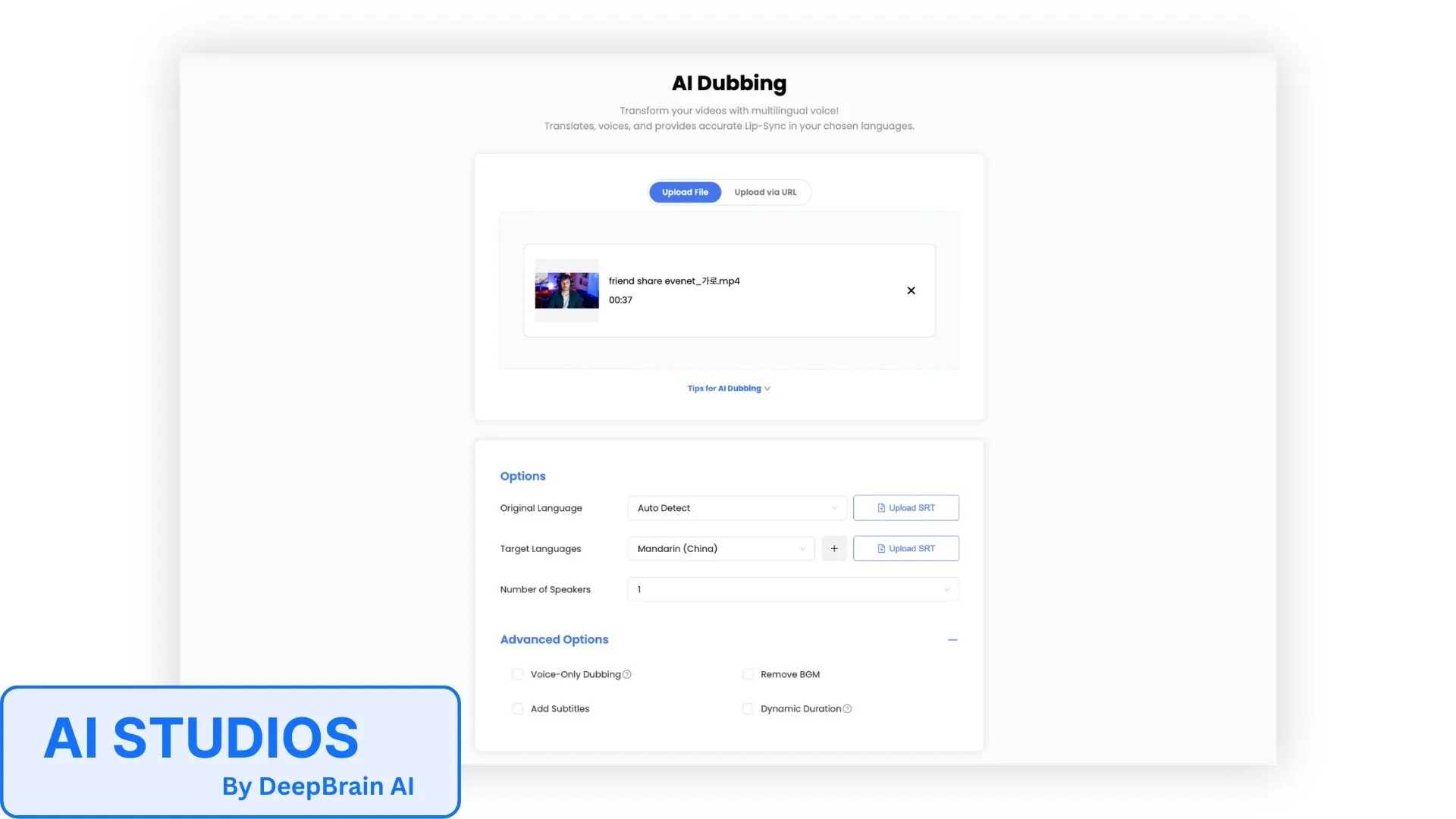
What We Liked and What Could Be Better
With AI STUDIO, you get a powerful AI video translation tool with advanced features even in the free plan. Users can perform AI video translation, remove or replace background music, add subtitles, and use dynamic duration to automatically adjust timing for smoother translations. The translated video may end up slightly longer or shorter than the original, though you can turn this off to preserve exact duration. The free plan also supports up to three languages per month under the three-video limit.
The interface is intuitive and clean, and while the free plan lacks a script editor, it still offers more flexibility than most competitors. Features like automatic lip syncing and AI voice cloning are included for free, giving AI Studios a strong edge over other platforms that reserve these tools for premium plans.
Overall, AI Studios provides one of the strongest free options we tested, with professional-level translation capabilities and user-friendly design.
Our Take on Pricing
- Unlimited video translation: Available on all paid plans
- Free plan: Great for testing the platform with three videos per month
- Personal and Team plans: Affordable options that unlock unlimited projects
- Lip-syncing included: A feature rarely available at all price levels
- Team plan: Adds advanced editing tools for more control
- Enterprise plan: Designed for organizations needing custom workflows
With over 150 supported languages and both video and audio translation, AI Studios by DeepBrain AI offers one of the best combinations of value, performance, and accessibility. See full pricing details on the AI Studios pricing page.
2. ElevenLabs
AI Translation Capabilities: Video & Audio (No Lipsync)
Languages Available: 29+ languages (V3 is reported to introduce 70+ languages)
Costs and Pricing (Based off automatic dubbing with watermark):
- Free: $0 / 5 dubbing minutes per month
- Starter: $5 / 15 dubbing minutes per month
- Creator: $11 / 50 dubbing minutes per month
- Pro: $99 / 250 dubbing minutes per month
- Scale: $330 / 1,000 dubbing minutes per month
- Business: $1,320 / 5,500 dubbing minutes per month
- Enterprise: Custom
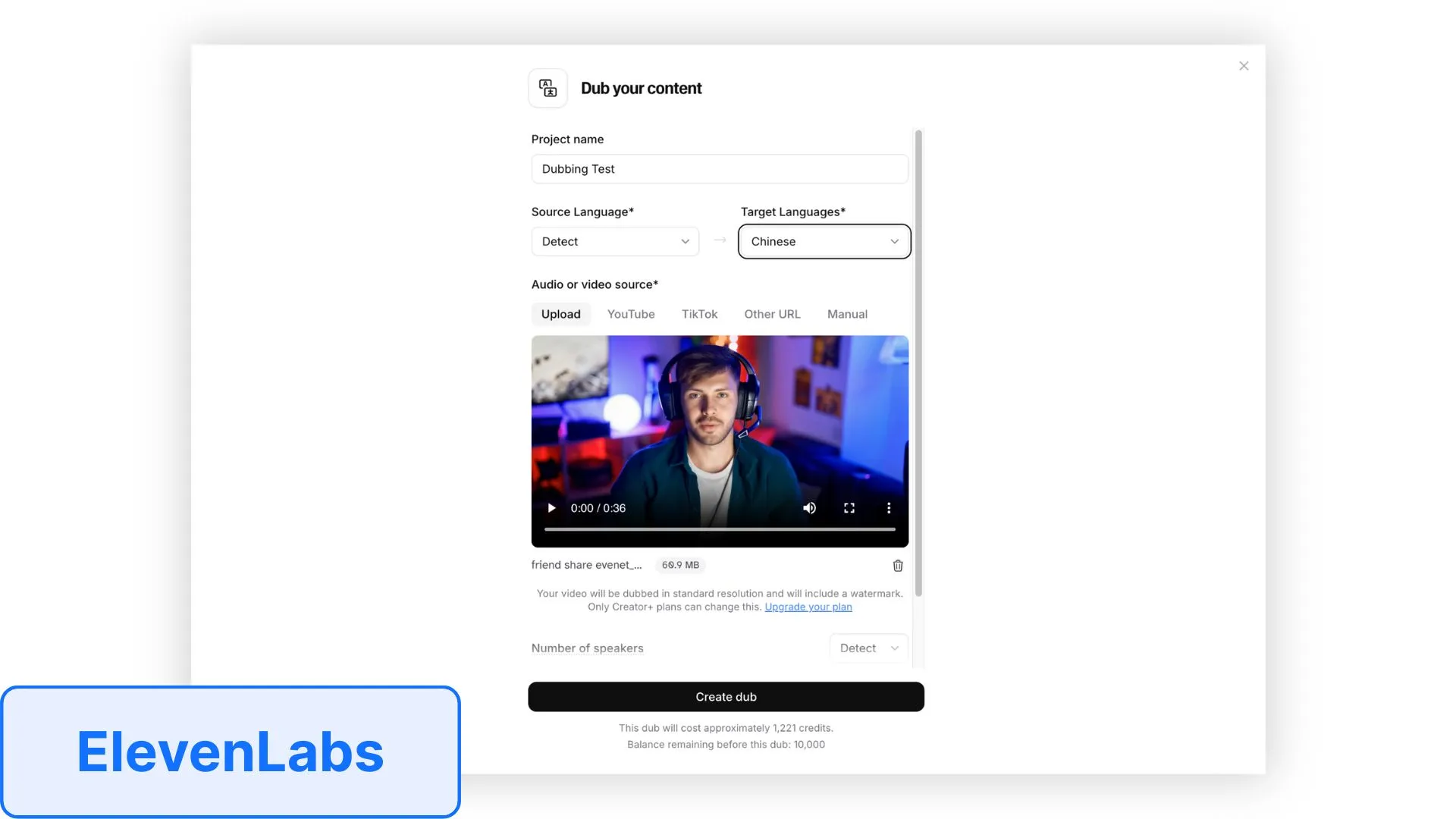
What We Liked and What Could Be Better
The ElevenLabs interface is clean, fast, and beginner-friendly. Dubbing takes only a few seconds, and the resulting voices sound natural, expressive, and well-paced. You can even dub select portions of a video instead of processing the entire file, which adds flexibility. However, ElevenLabs currently lacks a built-in lip sync feature for video translation.
The free plan has limited customization, but starting from the Starter tier, users gain access to the full editor and a wide range of tools, including:
- Translation and dubbing across 29+ languages
- Transcript editing and re-generation
- Delivery style adjustments and voice assignment
- Fine-tuning options for tone, timing, and stability
- Timecode synchronization and audio clip injection
- Voice isolation and multi-speaker separation
Overall, the free version is great for testing voice quality, while paid tiers unlock everything needed for professional translation or localization projects. A standout advantage is that AI Studios integrates ElevenLabs directly into its translation tool. Since ElevenLabs doesn’t include native lip syncing, using it within AI Studios combines its high-quality voice output with accurate, synchronized lip movements.
Our Take on Pricing
- Pricing scales across multiple tiers from free to enterprise-level
- Uses a credit-based system, where minutes reflect estimated dubbing time
- Lower-tier plans are affordable and suitable for testing or small projects
- Higher tiers offer larger allocations for professional workloads
- Great value for users who want high-quality dubbing without high upfront costs
ElevenLabs offers an excellent entry point for creators, educators, and small teams who want affordable access to AI-powered video translation. When paired with AI STUDIOS, it becomes an even more capable end-to-end solution for creating fully synchronized multilingual videos.
3. Dubverse
AI Translation Capabilities: Video & Audio (No Lipsync)
Languages Available: 60+ languages
Costs and Pricing:
- Pro: $18 / 50 credits per month (12.5 minutes per AI Dubbing per month)
- Supreme: $30 / 50 credits per month (12.5 minutes per AI Dubbing per month)
- Enterprise: Custom
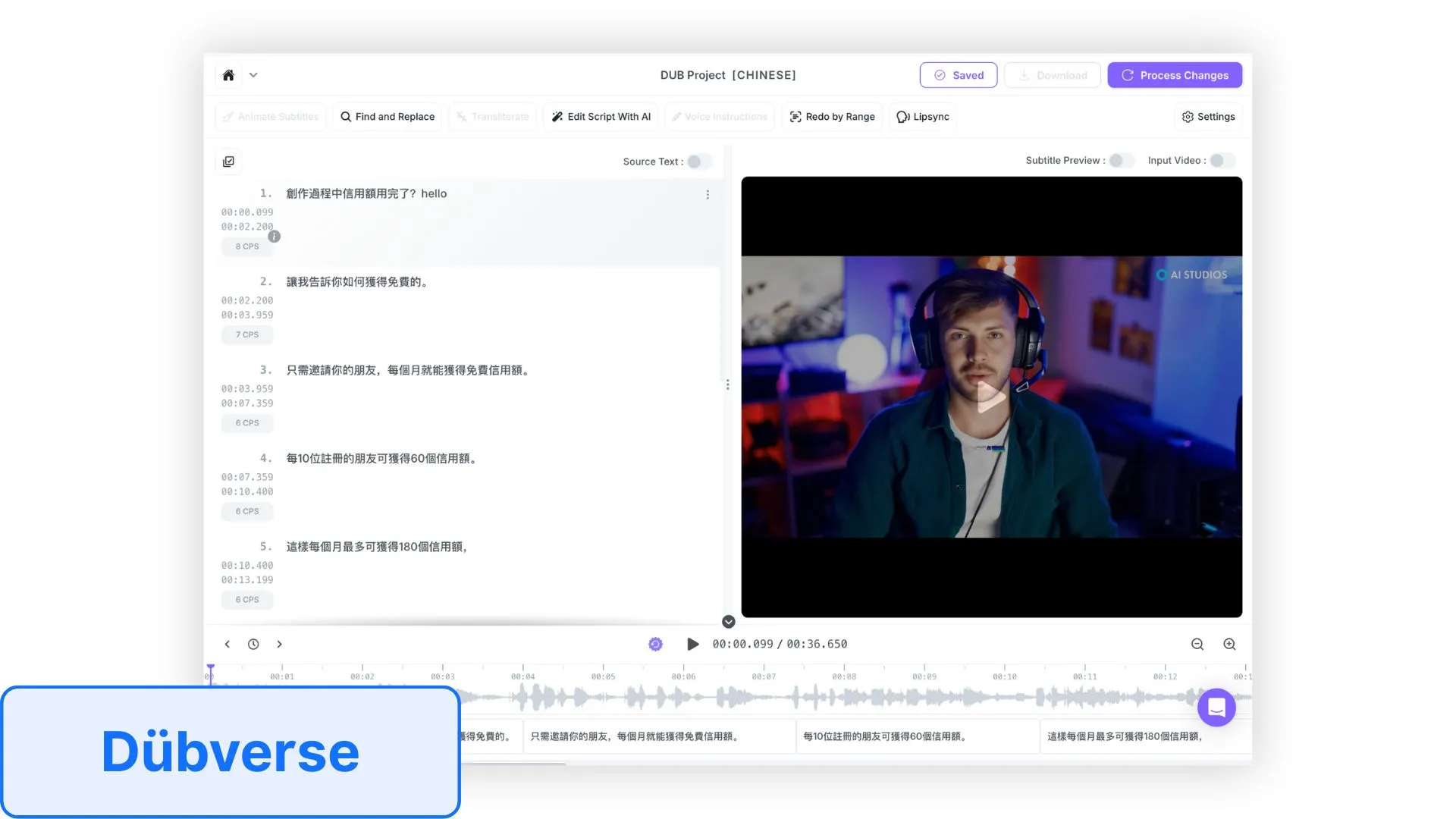
What We Liked and What Could Be Better
Dubverse offers a simple, beginner-friendly interface that makes script editing fast and intuitive. Users can adjust translations as often as needed, which is helpful for refining accuracy and tone. However, the free plan only allows a single video generation, and processing speed is noticeably slower than other AI video translation tools.
What We Liked:
- Clean and easy-to-use interface
- Unlimited script editing and translation refinement
- Excellent audio quality with natural, expressive voices
- Polished and professional-sounding output
What Could Be Better:
- Free plan limited to one video generation
- Slower processing times
- Most useful features, including lip sync, subtitles, and longer video support, are paywalled
Upgrading to a paid plan significantly improves the experience. Subscribers gain faster processing, access to advanced tools, and the ability to export multiple versions of a project. Paid tiers also enable better editing control, allowing users to perfect translations and produce higher-quality outputs without the one-generation limitation.
Our Take on Pricing
- Uses a credit-based system, with 4 credits per minute of translation
- Pro plan: 50 credits equals roughly 12.5 minutes per month
- Supreme plan: Same credits but includes added features and support
- Enterprise: Custom pricing for large-scale use
This credit model can work for light users, as credits can be scaled and cost less in bulk. However, compared to other AI video translators, Dubverse feels slightly restrictive and more expensive for longer or high-volume projects. Still, for users who value audio quality and clear, natural voice output above all else, Dubverse delivers excellent results.
4. Rask AI
AI Translation Capabilities: Video & Audio
Languages Available: 130+ languages
Costs and Pricing:
- Creator: $60 / 25 minutes for translation per month (no lipsync)
- Creator Pro: $150 / 100 minutes for translation per month
- Business: $750 / 500 minutes for translation per month
- Enterprise: Custom

What We Liked and What Could Be Better
Rask AI provides impressive performance, even in its free version. The voice cloning quality is notably realistic, producing clear and expressive output. However, most advanced tools are reserved for paid plans. With a subscription, you gain access to:
- Adjustable expression levels for more emotional delivery
- SRT subtitle upload and export
- Custom dictionaries for accurate terminology
- AI-assisted script editing and translation prompting
Lip syncing is available only from the Creator Pro plan and above. While many premium tools are paywalled, Rask AI’s overall quality and ease of use make it a strong contender for creators looking for professional localization capabilities.
Our Take on Pricing
- Premium-tier pricing: Rask AI is positioned as a higher-end platform
- Creator plan: Good for light users, but relatively expensive
- Creator Pro and Business tiers: Offer better value for professional or high-volume use
- Enterprise: Designed for teams with large translation needs
Rask AI supports over 130 languages and delivers strong dubbing quality across both audio and video. However, its pricing structure makes it less accessible to casual users. It’s best suited for professionals or organizations that need frequent, high-quality translations and are willing to invest in the added features and capacity.
5. Maestra AI
AI Translation Capabilities: Video & Audio
Languages Available: 125+ languages
Costs and Pricing:
- Basic: $49 / 120 minutes per month (no voice clone or lip-syncing)
- Premium: $99 / 100 minutes per month (no syncing)
- Business: $199 / 200 minutes per month (lip-syncing add-on $2 per minute)
- Business Plus: $449 / 500 minutes per month
- Enterprise: Custom
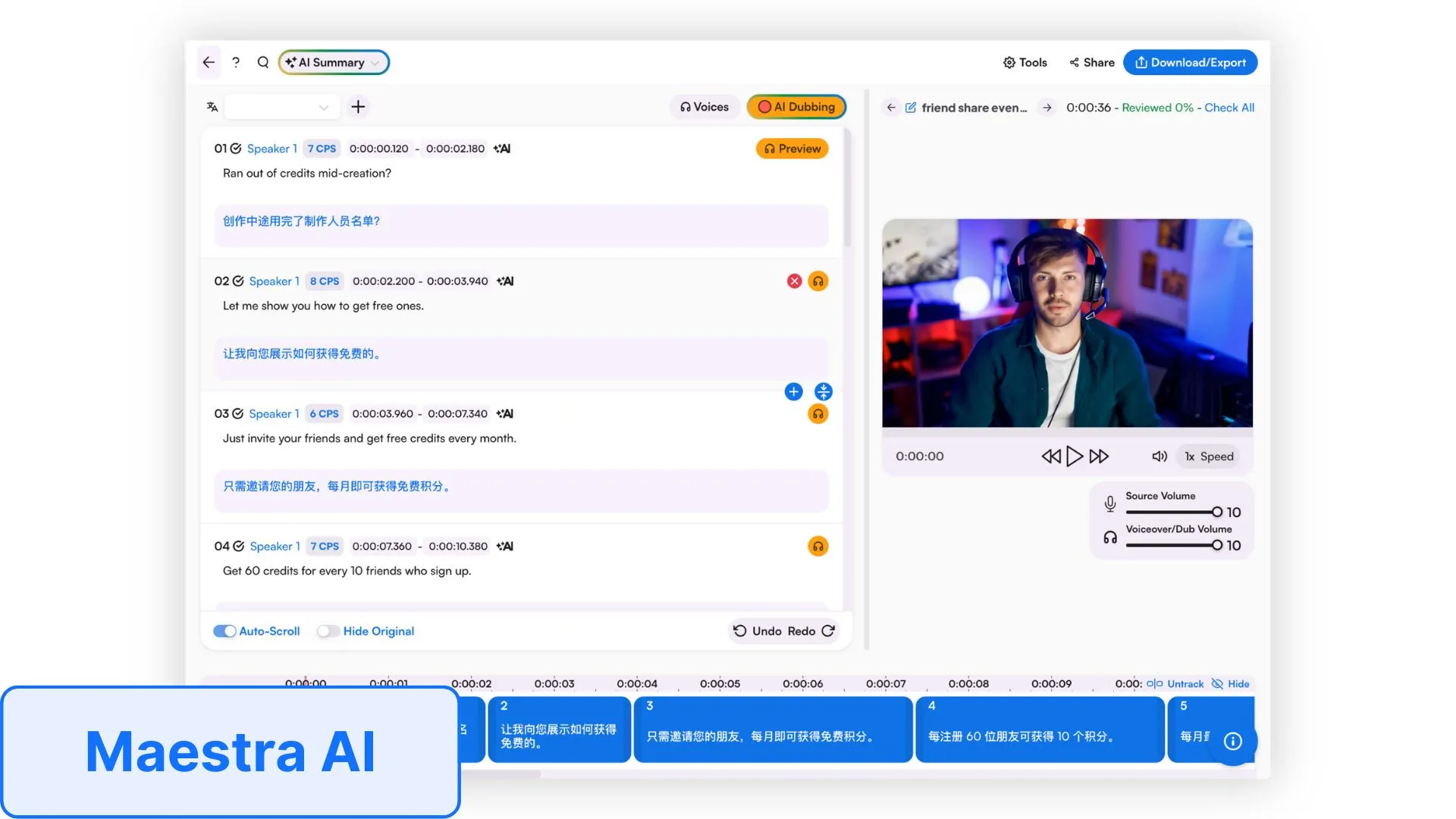
What We Liked and What Could Be Better
Maestra AI offers a surprisingly capable free version that includes a built-in editor for fine-tuning translations and adjusting timing. The interface is modern, clean, and easy to navigate, which makes it beginner-friendly and efficient for editing projects.
What We Liked:
- The free plan includes editing tools for translation and timing adjustments
- Interface is intuitive and user-friendly
- Supports both audio and video translation
What Could Be Better:
- Voice cloning is not available on the free plan
- Stock AI voices can sound robotic or less expressive
- The platform cannot separate background audio or music from the original speech
- Users must mute the original track entirely, leaving only the dubbed voiceover
Upgrading to a paid plan unlocks voice cloning for smoother and more natural output. However, the lack of automatic sound isolation limits flexibility compared to other platforms that can separate dialogue from background noise.
Overall, Maestra AI is a solid choice for users who need accurate translations and editing flexibility, but it’s best suited for projects where full sound mixing or background preservation is not essential.
Our Take on Pricing
Maestra AI’s pricing structure is more complicated than many competitors.
- The Basic and Premium plans provide limited minutes without access to lip-syncing.
- The Business tier unlocks lip-syncing, but only as a paid add-on at $2 per minute.
- Voice cloning becomes available at the Premium tier.
- The Business Plus plan expands usage but scales up in cost quickly.
While Maestra AI is powerful, its pricing model feels less economical and harder to navigate. Compared to other tools in this review, features like voice cloning and lip-syncing are locked behind higher tiers or add-ons that many competitors include in lower-priced or even free plans. This makes Maestra AI a tougher fit for users seeking straightforward value.
6. Vidnoz
AI Translation Capabilities: Video & Audio
Languages Available: 140+ languages
Costs and Pricing:
- Free: $0 / 2 4-minute videos per day
- Starter: $27 / 15 minutes per month
- Creator: $53 / 30 minutes per month
- Business: $495 / 300 minutes per month
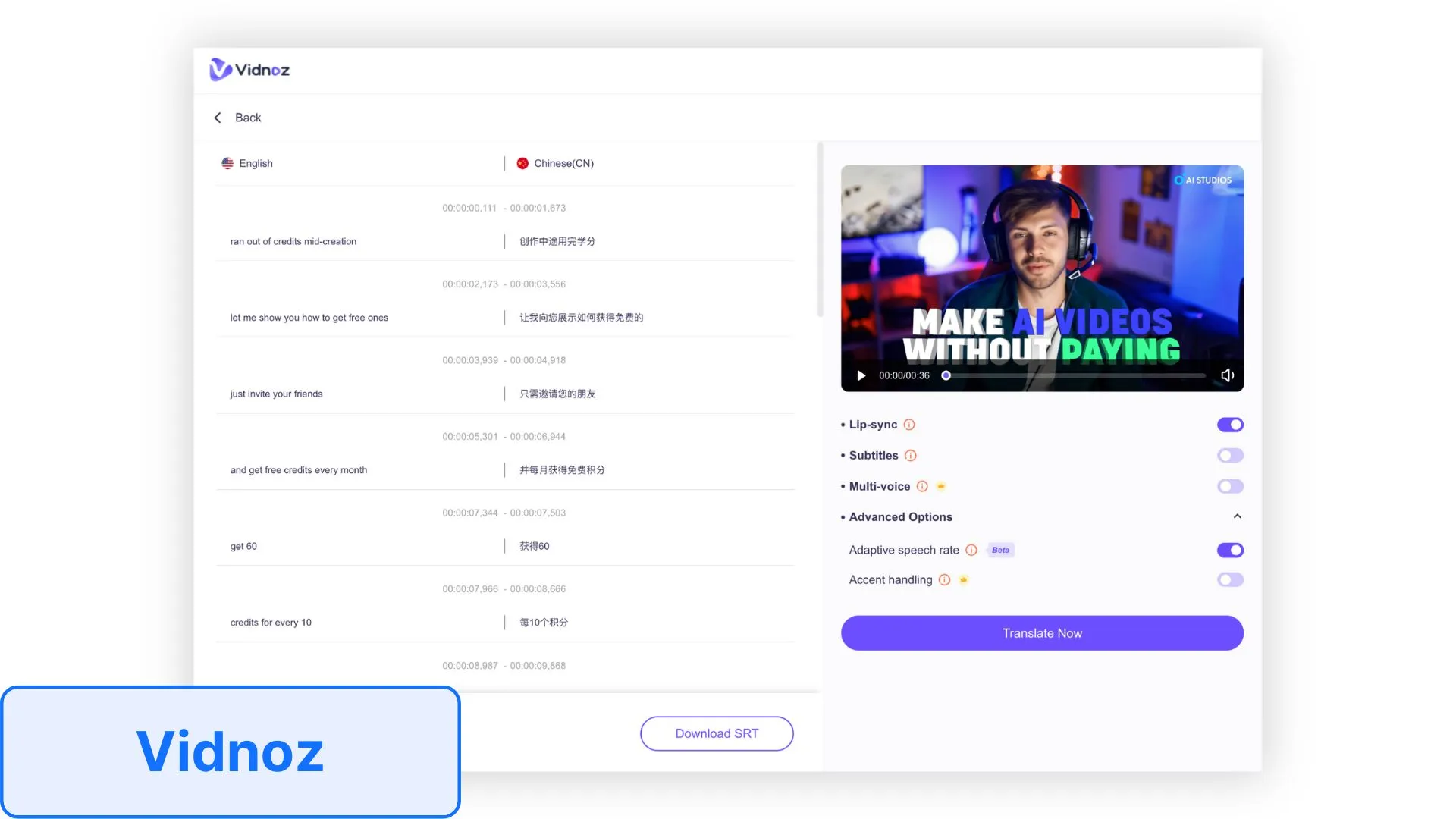
What We Liked and What Could Be Better
Vidnoz offers one of the simplest interfaces for editing translated scripts. Among all the platforms tested, it was the easiest to navigate, with a clean layout that makes workflow efficient. However, its simplicity comes at a cost — the editing tools provide minimal detail, which limits control over fine adjustments.
What We Liked:
- Extremely easy-to-use interface
- Quick script editing and navigation
- Supports multiple speakers and accents in paid plans
- Great for short, simple translation projects
What Could Be Better:
- Limited editing depth and customization
- Audio quality is weaker than competitors, with a slightly grainy sound
- Provides less feedback and detail during editing
Upgrading to a paid plan enhances flexibility while keeping the same intuitive interface. Paid tiers unlock:
- Multi-speaker support within a single video
- Accent customization and control
- Longer video creation
- Expanded monthly limits and export options
These additions make Vidnoz more practical for professional localization, although those who prioritize high-quality audio might prefer more advanced platforms.
Our Take on Pricing
- Free plan: Allows two 4-minute videos per day — ideal for testing or light use
- Starter and Creator plans: Limited to 15 and 30 minutes per month
- Business plan: Expands to 300 minutes per month but at a higher cost ($495)
While Vidnoz supports over 140 languages and provides a smooth experience for short-form content, its pricing model and weaker audio output make it best suited for smaller projects, demos, or teams experimenting with AI video translation before scaling up.
How AI Translators Work for Video and Audio
AI translators make it possible to experience video and audio in different languages while keeping the same tone and personality as the original performance. Instead of layering a simple voiceover, AI translation recreates the voice, timing, and emotion so the final result feels naturally produced in any language.
At a high level, here’s how the process works:
- Speech recognition transcribes the original dialogue into text
- Machine translation converts that text into the target language while maintaining cultural and linguistic context
- Voice cloning and text-to-speech generate a new audio track that sounds like the original speaker
- Lip sync matches the new audio to on-screen mouth movements for a natural look
Behind these steps are advanced AI systems that work together to produce seamless results. Speech recognition tools convert spoken words into text, while Neural Machine Translation models handle the language conversion. These systems are designed to go beyond literal translation, preserving tone, flow, and intent.
Next, the translated text is processed through AI voice generation models that create speech in the new language while keeping the speaker’s unique rhythm and vocal style. Finally, lip synchronization aligns mouth movements with the translated audio, making the video appear as though it was recorded in the target language.
Together, these tools make AI translation more than just converting words. They create localized versions of content that look and sound authentic for every audience.
Advantages of AI Translation
1. Natural, Context-Aware Results
Modern AI translation tools don’t just swap words between languages. They use advanced models to preserve tone, timing, and pacing so that translated videos and audio tracks sound natural and conversational.
2. Realistic Voice Reproduction
Voice cloning technology allows the original speaker’s voice to be recreated in another language. When paired with lip syncing, viewers experience both accurate translation and authentic expression, which makes content feel more personal and trustworthy.
3. Improved Accessibility
AI translators make content easier to access by adapting it for multilingual audiences. For learners, employees, and customers, hearing familiar voices in their own language improves understanding and engagement. For creators and organizations, it allows a single video or podcast to reach audiences worldwide without re-recording.
4. Efficiency and Scalability
AI translation tools make it easy to produce localized content at scale. Whether you need a short clip or a large catalog of videos translated, these systems can deliver in minutes. Features like automatic transcription, timing adjustment, and tone control reduce the time and cost compared to traditional methods.
Traditional Translation vs AI Translation
Traditional video and audio translation depends on manual work from translators, editors, and voice actors. While effective, it often comes with long timelines, high costs, and limited scalability.
The Traditional Translation Process
Conventional video or audio translation usually involves:
- Hiring professional translators and voice actors
- Recording new audio in studios
- Translating and adapting scripts to fit timing and tone
- Editing and mixing audio with video
- Repeating this process for each language
While this process can create high-quality results, it is often slow, expensive, and difficult to scale for multiple languages or large projects.
The AI Video and Audio Translation Process
AI translation software simplifies this workflow dramatically. Instead of relying on manual production, the platform automates transcription, translation, and voice generation in a few simple steps:
- Upload the original video or audio
- The AI transcribes the speech and translates it into the target language
- Select a voice or use voice cloning to preserve the original sound
- Generate and synchronize the translated version
- Optionally apply lip syncing for natural visual alignment
The benefits are clear:
- Faster results: Translations can be generated in minutes
- Lower costs: No studio time or multiple recordings required
- Scalable output: Translate into dozens of languages with consistent quality
- Greater control: Adjust tone, emotion, or timing directly in the platform
Traditional translation still offers unmatched emotional depth in creative projects like films or dramatic performances. However, AI translators excel in business, education, and digital communication, where speed, consistency, and clarity matter most.
AI Translation Market Trends
The global demand for AI translation tools is rising quickly as businesses, educators, and creators look for efficient ways to localize content. Video translation software is becoming essential for organizations that need to reach audiences in multiple languages without lengthy production cycles.
Recent research estimates that the global AI translation market could grow from under one billion dollars in 2024 to nearly three billion by 2033. This growth is driven by increasing demand for multilingual media, rapid improvements in AI speech technology, and the cost savings AI provides compared to traditional localization.
What’s Driving Growth
Several key factors are fueling the expansion of AI video and audio translation:
- Growing global need for accessible, multilingual content
- Advancements in voice cloning, lip syncing, and natural speech modeling
- Reduced dependence on studios and voice talent
- The rise of hybrid workflows that combine AI translation with human editing for high accuracy
- Adoption across industries including media, education, and corporate training
As the technology evolves, AI translators are set to play a central role in how global communication, entertainment, and education are produced and shared.
Frequently Asked Questions About AI Translators
Is AI translation safe to use?
AI translation is generally safe when handled through reputable platforms that use secure servers and data protection standards. Leading tools follow privacy regulations such as GDPR and CCPA. It’s still important to review how each provider manages user data and whether uploaded content is used for training AI models.
To stay safe, use trusted software, handle sensitive material carefully, and ensure you have permission to translate any copyrighted or personal content.
How do I translate a video with AI?
AI video translation tools make the process simple. You upload your video, select the target language, and let the platform handle transcription, translation, and voice generation. Once the translated version is ready, you can adjust timing, tone, or delivery as needed. Some platforms also offer lip sync so the translated audio aligns with the speaker’s mouth movements.
What’s the difference between AI translation and AI lip sync?
AI translation focuses on converting audio into a new language and generating a matching voice track. AI lip syncing ensures that mouth movements match the translated speech. When used together, the result feels more realistic and natural to viewers.
What makes a good AI video translator?
The best AI video translation tools combine accurate speech recognition, advanced language models, and natural voice generation. They handle translation with context rather than word-for-word output, produce expressive voices, and offer controls for pacing and tone. Strong privacy practices and clear pricing also make a big difference.
Which platforms offer AI video translation with lip sync?
Several platforms now offer both translation and lip syncing capabilities. Some include these features in all plans, while others limit them to premium tiers. It’s important to check which features are included before choosing a tool, especially if visual realism is a priority for your project.
How accurate is AI translation for emotion and tone?
AI translators have become much better at capturing emotion and speech rhythm, especially for business, learning, or marketing content. They maintain tone, pacing, and clarity effectively, though highly emotional or artistic material can still benefit from human voice performance. For most practical uses, AI translations sound clear, natural, and consistent.
What are the legal and ethical concerns around voice cloning?
Voice cloning should always be done with consent. A person’s voice is a unique part of their identity, so permission must be obtained before cloning or translating it. It’s also important to respect copyright when using voice recordings. Reputable AI translation platforms follow data protection laws and often provide pre-approved AI voices to avoid these issues.
What is the best free AI translator for video?
The best free AI translator tools allow users to create short translated videos or audio clips with realistic voices and clear synchronization. Some platforms include voice cloning and lip syncing even in free plans, while others limit advanced features to paid tiers. Look for options that balance accessibility, quality, and privacy for the most value.
How can AI translation support localization?
AI translation plays a major role in localization by adapting content to match language and culture naturally. Instead of simply translating words, AI can modify tone and phrasing to fit regional preferences. For example, an AI video translator can create localized versions of marketing campaigns, training materials, or product tutorials without the need for new production. This makes global communication faster and more cost-effective.
What’s the difference between an AI audio translator and an AI video translator?
An AI audio translator focuses on sound, converting speech into text, translating it, and generating a new voice track. It’s ideal for podcasts, webinars, or voice recordings. An AI video translator adds a visual layer by synchronizing the translated audio with on-screen speech and expressions. This creates a complete viewing experience that feels natural in the target language.



